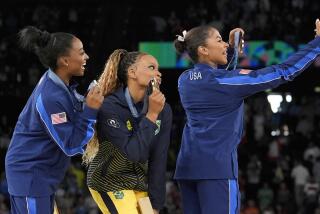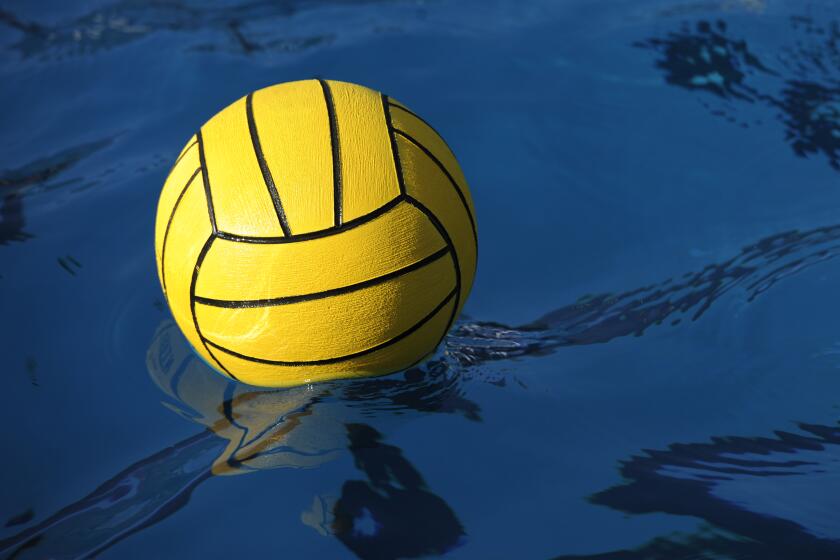It’s Still a Big Number : In 1972, Title IX Was to Provide Equality for Girls’ Sports, but Problems Still Exist
Until the early 1970s, girls’ high school athletic competition was treated like a social event. Punch and cookies were served after an intramural basketball game or field hockey match.
There were no section or State championships to be won. No pep rallies or long bus trips to special competitions. Interscholastic athletics, after all, was for the boys .
But 20 years later, girls’ athletics has come a long way. Boys’ State championship banners share wall space with those won by girls.
Girls who risked name-calling and ostracism for playing sports in the 1970s find that today’s athletes are among the most popular on campus.
A piece of federal legislation--Title IX--has been the driving force behind this change.
On June 23, 1972, President Nixon signed Title IX into law. It read: “No person in the United States shall, on the basis of sex, be excluded from participation in, be denied the benefits of, or be subjected to discrimination under any educational program or activity receiving Federal financial assistance.”
Since then, participation in girls’ athletics has increased nationwide. According to the Women’s Sports Foundation, nearly 1.9 million girls competed in high school athletics in 1991. Only 294,000 competed in 1971.
Meanwhile, the number of boys participating in high school athletics has decreased from 3,666,917 in 1971 to 3,406,355 in 1991.
But how much of an impact has Title IX really made on girls’ high school sports? How has it been enforced? In what direction is girls’ athletics headed? Is there still discrimination?
Members of The Times’ Orange County high school sports staff posed these questions to administrators and coaches during a recent panel discussion.
The panel: Sandy Blumenthal, La Habra girls’ volleyball and badminton coach; Sheri Ross, El Toro High girls’ athletic director and swimming coach; Stan Thomas, Southern Section commissioner, and Mark Trakh, Brea-Olinda girls’ basketball coach.
Participants were given a list of questions in advance, but the conversation did not follow any predetermined format.
Some excerpts from the discussion:
Q. If Title IX is not being as effective as it was intended, what needs to be done to enforce it? Are high schools in violation of Title IX mandates?
A. Ross: I think every school district has an administrator who has some understanding of Title IX. I do believe in physical education we have some Title IX violations. I don’t think we have all co-ed physical education. The State CIF is passing a bylaw, (providing) a place to file a question, a problem or complaint with Title IX. This came about because of the problems we had with the Bacerra bill, the people who were interested in having girls on boys’ teams.
Q. The Bacerra bill, if passed into law, would allow girls to compete in boys’ sports, even if the school has a girls’ team in the same sport. However, boys would not be allowed to try out for girls’ teams.
The bill has already passed through assembly and if it passes through the State Senate, it would take effect July 1, 1993. There is a lot of concern among administrators who think it could hurt both boys’ and girls’ athletics. What do you think?
A. Thomas: There are people who would like to govern the CIF other than the principals of our organization. We have a very powerful group of women up there who are working very closely with Delaine Eastin, the chairperson of the assembly education committee, and I believe Delaine has her eyes set on being the state superintendent of schools. She’s very powerful, very political and is very much in tune with the group of women attorneys up in Sacramento who are pressing for what they call equality in girls’ athletics.
I fail to see the equality, however, when we deny boys the opportunity to play on girls’ teams, when, by law, we would have girls playing on boys’ teams. That seems to be a bit out of context.
I also feel very strongly that the financial implications of the Bacerra bill, based on the school finance picture today, could be detrimental and would cause a greater weaknesses in interscholastic athletics if we are forced to provide a girls’ football team and schedule it. The state has a great concept of mandating programs and not funding them. This is not new. It was something that drove us nuts when I was a principal.
If girls are going to play on boys’ teams, I don’t think it will be a big impact. We have girls playing on boys’ teams today--football, wrestling, water polo. It’s a choice. If they prefer to do that, so be it. But the danger lies not so much in the passage of this legislation, but how Sacramento is dealing with the CIF as it relates to its independence and governing itself. We have our concerns that there could be a group of people at the state level who would like to take over the CIF.
Q. What about girls participating on boys’ teams? Do you encourage it?
A. Thomas: You see girls participating in an all-boys’ contact sport, I think it’s wrong, personally, because of the danger involved. But they have every right to do it. I keep thinking of a young lady in high school last year who was all-league in football. She was about 145 pounds and got bounced around a lot, but she played the whole season and did well.
We’ve tried to discourage girls from playing football, certainly at a varsity level, because of the danger.
Blumenthal: Would the same be true for a boy, because of the danger?
Thomas: I don’t think the girls have the upper body strength that boys do. And that’s the difference. In Garden Grove not long ago, we had three girls who wanted to play football. They had made up their minds to play. The district called up and said they weren’t going to let them play, and I told (the district) that I couldn’t support that. I talked to the father and told him, “Why don’t you take your daughters and your wife and go down to the practice field and stand next to the guys while they’re drilling and see if you really want your daughters to be part of that.” I don’t think they played. I never heard any more from them. You stand at a drill with 17- or 18-year-old men who are quick, strong and aggressive, I wouldn’t want my daughter out there. It would be crazy. She can play a lot of things. She doesn’t need to be out there in a football uniform. It’s just common sense. They play, though, and they’re entitled to play.
Q. Do you feel there is a substantial problem with sexism among administrators, coaches or the public when it comes to funding girls’ sports?
A. Blumenthal: At our school, from the beginning, the men and women coaches have always gotten along. . . . But when I look, I haven’t noticed at our school a coach-teacher being hired for a girls’ sport. I’ve noticed coach-teachers being sought for boys’ sport. It’s like, “We need a baseball coach, and we need an English teacher.” All of a sudden, we hire an English teacher who also can coach the baseball team. I haven’t seen that done at our school with the girls’ sports. I don’t know if it’s by chance or because it’s not as important as boys’ sports.
Trakh: I can honestly say I haven’t encountered sexism to a great degree at Brea. As far as on-campus people being hired, if you look around the county and every time there’s a job opening for a girls’ coach, chances are it will be a walk-on position. If it’s a boys’ coach, chances are it will be an on-campus teaching position. A lot of people ask why there is a disparity between the scores in girls’ basketball. If you look, you have stability in the strong programs every year, and have instability in the weaker ones because they have a turnover in walk-on coaches. I think that’s where you see it subtly.
When I coach all-star teams, I’ll ask the players, “Are the girls’ basketball teams just as important as the boys’ teams on campus?” And the kids say, “No way, are you kidding? They (boys) get the gym. And they care more about the boys than they do us.” I get that answer 80% to 90% of the time. You won’t get that answer at Brea.
Ross: I would say sexism exists everywhere, to a small degree. I can give a good example at our school. When Bob Johnson resigned as football coach (in 1991), we hired a great gentleman by the name of Mike Milner to replace him. But a teaching position was created for him. They don’t do that very often. We are in the process of hiring a girls’ basketball coach right now, and I can just about guarantee you that there won’t be a teaching position for her. She might be able to look into one, but there won’t be one created for her. I think it (sexism) exists.
NOTE: Denise Christensen was hired as El Toro’s basketball coach last Friday. She was not offered a teaching position. Christensen is still working toward a teaching certificate.
Q. Are girls’ sports at a disadvantage because of the hiring process? Are women being discouraged to enter coaching?
A. Thomas: It doesn’t just stem from athletics. It starts with our universities and our training programs. We are seeing fewer coaches being trained at universities and then coming into our high schools as physical education teachers. Today we see the English teacher or the math teacher who has a general interest in athletics becoming that coach. If we did a section survey of incoming teachers, there would be a minute number of physical education teachers.
Ross: You have those who are trained as physical education teachers, and when they come to a high school, there are no physical education teaching positions available for them. That’s the tough thing.
Thomas: There are fewer unit requirements. It used to be four years of P.E. Today it’s two. When you talk to physiologists, you’ll see a diminishing result in physical fitness with young people. It’s already critical. There are few kids who can pass basic performance tests--running, jumping, pullups. They can’t do it because they’re television addicts and they’re not out in the street playing what they used to play.
Trakh: I think it’s a problem. If you look at the CIF girls’ basketball finals this year, only one team--Alemany--was coached by a woman. Ten years ago we were saying when a lot of these girls were going through college programs: “When these women graduate, they’ll come back to coach.” It’s 10 years later and they haven’t.
If you look at a lot of applications, even walk-ons, all the applicants are male. I don’t know what the problem is, but I think an effort needs to be made at the high school level. I know it is on the college level, for women to coach women. I think there are as many qualified women who have gone through the process as have the men who are walking on. Granted, it’s not what it used to be with the colleges training them. And I don’t think there’s (been) a woman coach in my league for some time. . . . Every time I ask one of my kids if they want to go into coaching they say, “Are you crazy? I want to make some money.” They’re too smart.
Q. Are you satisfied with the growth of girls’ athletics in terms of the number of girls participating--the number of teams, the number of levels available (freshman-sophomore, junior varsity, varsity)? What improvements need to be made?
A. Ross: I would have to say that I’m satisfied. In our (Saddleback) district and those around us, I think the levels of sports for girls has grown. In the years when I started, we had varsity and sometimes junior varsity, and we’ve expanded into frosh-soph in almost every one of our sports. That pleases me.
But now we’re facing cutbacks in our district and in the Capistrano Valley district. The Capo Valley district is looking at a 20% cutback, and we’re looking at a $50,000 cutback in athletics. I think the districts are looking at the entire schemes and cutting lower level teams. And my concern is that if they cut the lower level teams, I hope it will be done across the board and not just girls’ sports. (Otherwise) we will get into a Title IX issue. But I think there is equal opportunity.
Blumenthal: I’ve been at La Habra 22 years, and I came in right at the time the changes were being made. I know there was a lot of discussion at the time about, “Do we really want to go where the boys are now? Is that really what we want?” We were at such an advantage that we could watch ourselves grow, but in the right direction, not toward all the things where boys’ athletics were growing to.
I would like to be a high school student today and have the opportunities the girls have today. Then I look back to when I was in high school, we had GAA and 150 members who could experience and enjoy sports in a much less competitive nature and still get the benefit from sports. There are some girls who aren’t getting those benefits today because they’re getting cut from teams.
It’s so competitive now. . . . Sometimes when I watch athletes perform, I wonder if they’re really enjoying it. I think sometimes we have to look back and say, “What are our objectives?” Has it become the best skilled player we need to win? Are we growing in the right direction? We need to make sure we’re including more than just the top skilled people.
The competition is so fierce that kids picture each other as enemies rather than (friends). In the old days, in GAA, it (sports) was a special thing. We had punch and cookies afterward and we liked doing the same thing. Now it’s so competitive . . . and when it’s over, I would like to see the punch and cookies come back.
Trakh: Sandy’s touching on an interesting philosophical point of view. It’s not just unique to girls. The direction we’re going is competitive. We’re very competitive. But I don’t think friendships are lost in competitiveness.
We play teams from all over the country, and our kids have maintained relationships with them. They’ve met players from New York and maintained writing relationships with them. They play with other teams in spring leagues. We played Capistrano Valley in the finals of the Irvine tournament last season. It was very competitive. Kids were diving all over the place. It was a super-intense atmosphere, the way they went at each other. But after the game, both teams respected each other, the players were hugging each other. They wrote letters to us after the game. We wrote letters to them.
So it’s not necessarily an all-or-nothing proposition. You can maintain the competitiveness and at the same time, when the game is over, shake hands and gain friendships. One thing about the punch and cookies, one time our team was uptight, we were pushing them one time before the CIF championship, and we had them do a lot of fun drills and brought out the punch and cookies. It was fun for them.
Blumenthal: I agree that it’s a philosophy. But I would hate to see us lose the social part of it.
Q. Has there been any one female athlete from Orange County whom you feel contributed to the rise in popularity of girls’ sports? Any administrator, coach, or public figure who helped it along more than others?
A. Blumenthal: I would have to say at our school it was Tex Wallis, just because of his transition from boys’ basketball coach to girls’ basketball coach and his acceptance of girls’ sports (in the mid 1970s). I would point to someone like Mark (Trakh) as someone who brings recognition to the whole county. That program has a lot of recognition. I would say (former Connelly basketball star) Ann Meyers was one of the first Orange County athletes during the switch over (in the 1970s), so she would be a role model.
Thomas: I think women are taking over, there’s no question about it. Look at how many principals we have now who are women. Just from a section standpoint, we don’t deal with that , but we have had great women athletes. Lisa Leslie as of late. . . . The quality of athletics today. . . . Look at volleyball, my God, women play volleyball better than the guys ever thought of playing. Softball, I would hate to have to get up and hit against a softball pitcher today. It really has taken athletics to a new level. We’re at a new level now because of the girls. And they are, without question, competitive. We see a well-rounded group of women from the Southern Section who have gone on to compete at the collegiate and even the professional level.
Trakh: Da Houl (Brea basketball player who graduated in 1983 and is now a Ladycat assistant coach) was the first who changed the image of what a girls’ basketball player should be. She was very skilled and was an excellent role model, great in the classroom and on the court. It wasn’t really that accepted then to be a girls’ basketball player. Of course, now it is. But she began to change that thought.
More to Read
Get our high school sports newsletter
Prep Rally is devoted to the SoCal high school sports experience, bringing you scores, stories and a behind-the-scenes look at what makes prep sports so popular.
You may occasionally receive promotional content from the Los Angeles Times.






